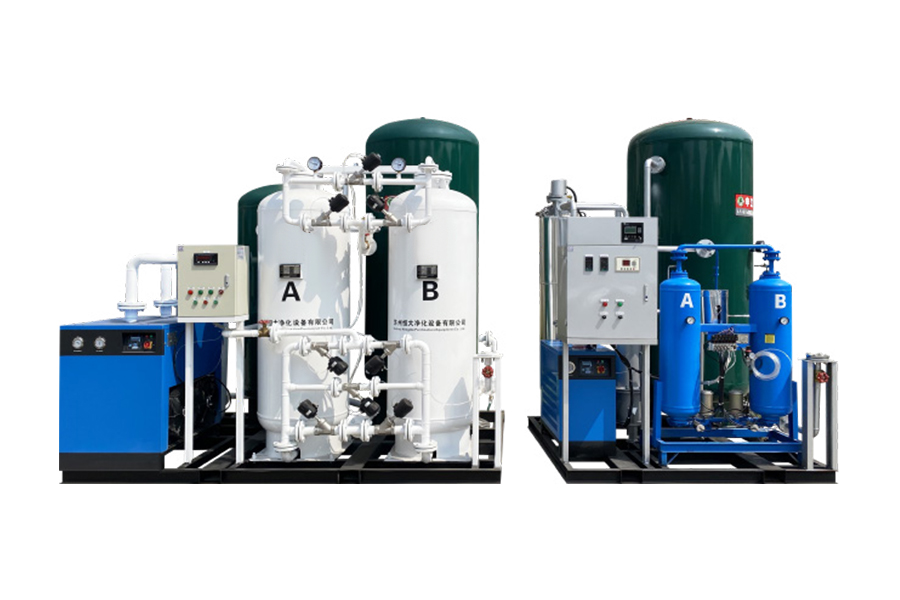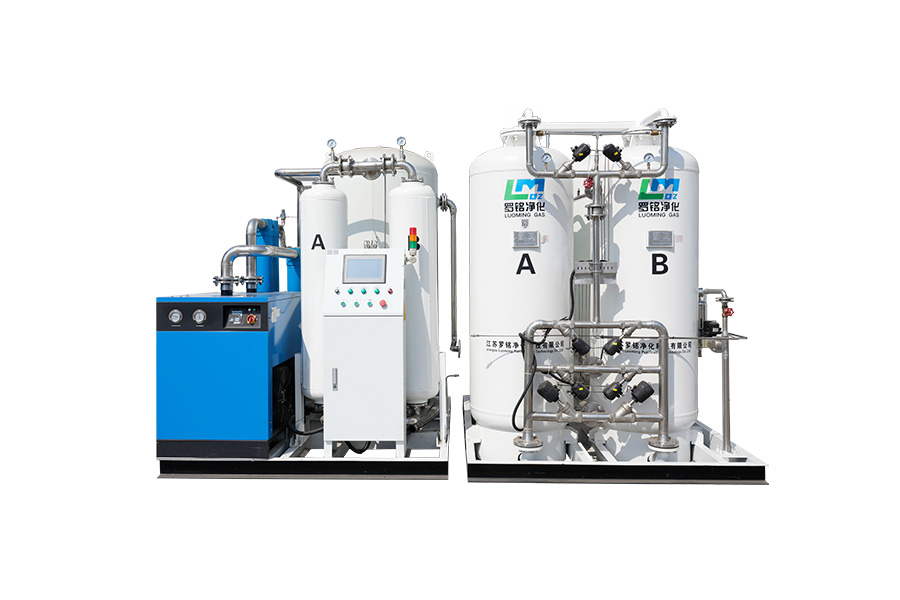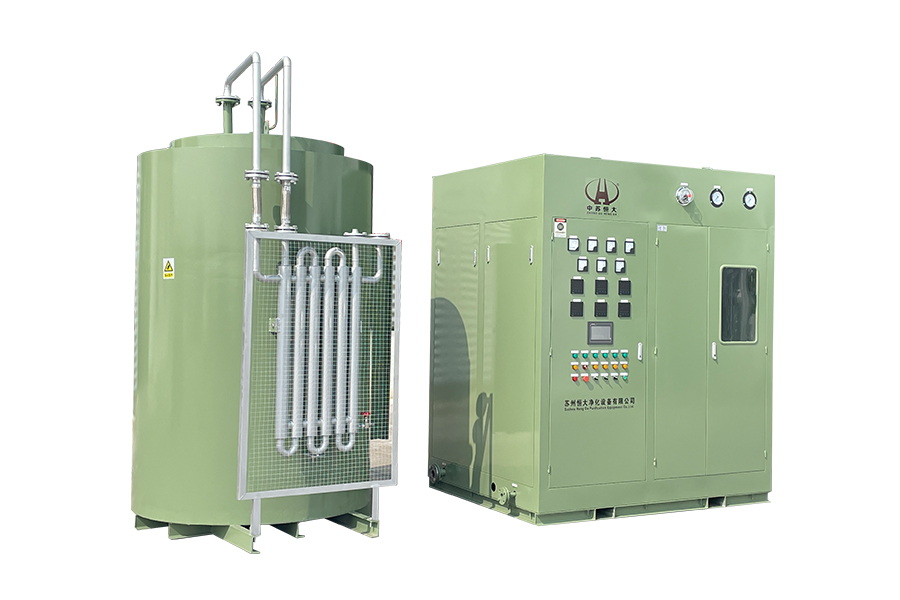Introduction
Nitrogen is an inert gas, meaning it doesn't easily react with other substances. This unique property makes it incredibly valuable across a wide range of industries, from preserving food to preventing explosions. Traditionally, businesses would rely on purchasing nitrogen in cylinders or liquid form, which can be costly and logistically challenging, especially for operations requiring high volumes.
This is where high-flow nitrogen generators come in. These innovative systems allow businesses to produce their own nitrogen on-site, providing a reliable, cost-effective, and environmentally friendly alternative to traditional supply methods. As industries continue to grow and demand for nitrogen increases, understanding the benefits and functionality of these generators becomes crucial for optimizing operations and achieving greater efficiency.
Nitrogen generators essentially separate nitrogen from the air we breathe. Air is composed of approximately 78% nitrogen, 21% oxygen, and 1% other gases. Nitrogen generators utilize two primary technologies to achieve this separation: Pressure Swing Adsorption (PSA) and Membrane technology.
Pressure Swing Adsorption (PSA) Generators:
PSA generators work by passing compressed air through a vessel filled with a material called Carbon Molecular Sieve (CMS). The CMS selectively adsorbs (or traps) oxygen molecules and other trace gases, allowing the nitrogen molecules to pass through and be collected. When the CMS bed becomes saturated with oxygen, the pressure is released, and the oxygen is vented back into the atmosphere, regenerating the CMS for the next cycle. PSA systems typically use two such vessels, alternating between adsorption and regeneration, to provide a continuous flow of nitrogen.
Membrane Generators:
Membrane generators use a semi-permeable membrane made of hollow polymer fibers. Compressed air is pushed through these fibers. Nitrogen molecules permeate through the membrane at a slower rate than oxygen, water vapor, and other gases. This difference in permeation rates allows for the separation of nitrogen, which is collected at one end, while the other gases are vented out. Membrane systems are generally simpler in design and operation compared to PSA systems.
Key Applications of Nitrogen Generators
Nitrogen's inert nature and versatility make it indispensable across a multitude of industries. High-flow nitrogen generators provide a reliable and efficient way to meet the diverse demands of these sectors.
Industrial Manufacturing
In general industrial manufacturing, nitrogen is widely used for various purposes. It's often employed as an inert blanket to prevent oxidation of materials, purge systems of unwanted gases, or as a component in specialized atmospheres for heat treatment and brazing processes. Many critical manufacturing processes, such as laser cutting, also rely heavily on a consistent and high-purity nitrogen supply.
Nitrogen Generator for Laser Cutting
Laser cutting is a prime example where high-flow, high-purity nitrogen is essential. In laser cutting, a powerful laser beam melts and vaporizes the material. Nitrogen is used as an assist gas to blow away the molten material from the cut kerf, preventing dross formation and creating a clean, smooth edge. The purity and flow rate of the nitrogen directly impact the quality and speed of the cut. Impurities in the nitrogen can lead to oxidation, discoloration, and a rougher cut edge.
Food & Beverage Industry
The food and beverage industry leverages nitrogen extensively for its ability to displace oxygen, which is a primary cause of spoilage. By creating an inert atmosphere, nitrogen helps to preserve the freshness, flavor, and shelf life of various products.
Nitrogen Gas for Food Packaging
A significant application in food and beverage is Modified Atmosphere Packaging (MAP). In MAP, the air inside food packaging is replaced with a specific gas mixture, often predominantly nitrogen. This process inhibits the growth of spoilage-causing bacteria and fungi, preventing oxidation of fats and oils, and maintaining the product's texture and appearance. From snacks to fresh produce and prepared meals, nitrogen plays a vital role in keeping food fresher for longer.
Oil & Gas
The oil and gas industry utilizes nitrogen for a wide array of critical operations, especially for safety and process integrity. Its inertness makes it ideal for purging pipelines, well stimulation, and creating inert blankets in storage tanks.
Nitrogen Generator for Oil & Gas Industry
In the oil and gas industry, nitrogen generators are crucial for on-site production, reducing the need for costly and hazardous transportation of gas cylinders or liquid nitrogen. Key applications include:
Pipeline Inerting and Purging: Clearing pipelines of flammable gases before maintenance or to prevent explosions.
Well Stimulation: Using nitrogen pressure to enhance oil and gas recovery from wells.
Tank Blanketing: Creating an inert atmosphere in storage tanks to prevent oxidation and fires.
Drilling Operations: Used in certain drilling techniques to control pressure and prevent blowouts.
Pharmaceuticals & Electronics
Both the pharmaceutical and electronics industries demand extremely high levels of purity to prevent contamination and ensure product integrity.
In pharmaceuticals, nitrogen is used for:
Inerting Reaction Vessels: Preventing oxidation and contamination during chemical synthesis.
Product Transfer: Safely transferring sensitive powders and liquids.
Packaging: Creating inert atmospheres for sterile packaging of medicines.
In electronics manufacturing, nitrogen is vital for:
Soldering: Preventing oxidation during soldering processes, especially in reflow ovens, to ensure strong, reliable connections.
Cleanrooms: Maintaining ultraclean environments by purging contaminants.
Component Storage: Protecting sensitive electronic components from moisture and oxidation.
Here's a table summarizing some key applications:
| Industry |
Primary Application of Nitrogen |
Benefit of Using Nitrogen |
| Industrial Manufacturing |
Inerting, purging, laser cutting assist gas |
Prevents oxidation, improves cut quality, enhances safety |
| Food & Beverage |
Modified Atmosphere Packaging (MAP), product blanketing |
Extends shelf life, preserves freshness and quality |
| Oil & Gas |
Pipeline inerting, well stimulation, tank blanketing, purging |
Enhances safety, prevents fires, improves recovery |
| Pharmaceuticals |
Inerting reaction vessels, product transfer, sterile packaging |
Prevents contamination, ensures product integrity |
| Electronics |
Soldering, cleanroom purging, component storage |
Prevents oxidation, ensures product reliability |
Benefits of Using Nitrogen Generators
Opting for an on-site nitrogen generator rather than relying on external suppliers brings a host of significant advantages for industrial operations. These benefits extend beyond simple convenience, impacting a company's bottom line, operational efficiency, and environmental footprint.
Cost Savings
One of the most compelling reasons to invest in a nitrogen generator is the substantial cost savings it offers. When you purchase nitrogen in cylinders or bulk liquid form, you're not just paying for the gas itself; you're also paying for transportation, handling, storage, and often, rental fees for cylinders or tanks. These recurring costs can add up significantly over time, especially for high-volume users. An on-site generator eliminates these external charges, reducing operational expenses dramatically. Furthermore, the cost of producing nitrogen on-site is often much lower than the market price for delivered gas, leading to a rapid return on investment.
Continuous Supply
Relying on external nitrogen suppliers means you're subject to their delivery schedules, potential delays, and the risk of running out of gas. A shortage of nitrogen can bring critical production processes to a halt, leading to costly downtime and missed deadlines. With an on-site nitrogen generator, you have a continuous and on-demand supply of nitrogen, twenty-four hours a day, seven days a week. This ensures uninterrupted operations, allowing you to maintain consistent production levels and avoid supply chain disruptions. You generate exactly what you need, when you need it, directly at the point of use.
Energy Efficiency
Modern nitrogen generators are designed with energy efficiency in mind. While they do require electricity to operate, advancements in technology have made them increasingly efficient at separating nitrogen from air. Compared to the energy expended in liquefying nitrogen at cryogenic plants, transporting it over long distances, and then regasifying it, on-site generation can often present a more energy-efficient solution overall. Furthermore, many systems feature advanced controls that can adjust nitrogen production based on real-time demand, preventing over-generation and conserving energy. This not only lowers operational costs but also contributes to a smaller carbon footprint, aligning with growing corporate sustainability goals.
How to Choose the Right Nitrogen Generator
Selecting the appropriate nitrogen generator for your industrial application is crucial to maximize benefits and ensure efficient operation. Several key factors need to be considered to match the generator's capabilities with your specific requirements.
Flow Rate Requirements
The most critical factor in choosing a nitrogen generator is determining your required flow rate. This refers to the volume of nitrogen gas needed per unit of time (e.g., cubic feet per minute or liters per minute). Accurately assessing your peak and average nitrogen consumption is essential. Underestimating your flow rate can lead to insufficient supply and production bottlenecks, while overestimating can result in an unnecessarily large and more expensive system. It's often advisable to conduct a thorough audit of all processes that use nitrogen to get a precise understanding of your current and future demands.
Purity Levels
Different applications require different levels of nitrogen purity. For instance, laser cutting and electronics manufacturing typically demand very high purity (e.g., 99.999% or higher) to prevent oxidation and ensure product quality. In contrast, tank blanketing or tire inflation might only require a lower purity level (e.g., 95-98%). Understanding the exact purity required for each of your applications is vital. Generating unnecessarily high purity nitrogen can be more energy-intensive and costly. Modern generators offer adjustable purity settings to meet diverse needs efficiently.
PSA vs Membrane Technology
As discussed earlier, the two primary technologies for nitrogen generation are Pressure Swing Adsorption (PSA) and Membrane. The choice between these two depends on your specific application:
PSA Generators: These are generally preferred when higher purity nitrogen (typically 99% to 99.999% and above) is required, often at higher flow rates. They are robust, reliable, and can achieve very high purities suitable for sensitive applications like laser cutting, electronics, and pharmaceuticals.
Membrane Generators: These are often chosen for applications requiring moderate purity nitrogen (typically 95% to 99.5%) and for lower to medium flow rates. They are simpler in design, often more compact, and can be more cost-effective for applications where ultra-high purity isn't critical, such as tire inflation or some food packaging applications.
Consider the purity and flow rate needs together when evaluating which technology is best suited for your operations.
Portable vs Fixed Systems
Nitrogen generators are available in both fixed (stationary) and portable configurations:
Fixed Systems: These are permanently installed on-site and are ideal for facilities with consistent, high-volume nitrogen demands. They are typically larger, more powerful, and integrated into the facility's existing infrastructure.
Portable Systems: These are designed for mobility and are suitable for temporary projects, remote locations, or applications where nitrogen is needed at various points within a facility. They are often skid-mounted or trailer-mounted for easy transport.
Maintenance Tips
While modern nitrogen generators are designed for robust and reliable operation, regular maintenance is key to ensuring their longevity, efficiency, and continued supply of high-purity nitrogen. Neglecting maintenance can lead to reduced performance, increased energy consumption, and costly breakdowns.
First and foremost, it's vital to follow the manufacturer's recommended maintenance schedule. This schedule typically outlines specific tasks and their frequency.
A primary area of focus is the air compressor and its filtration system. Since the generator relies on a clean, dry air supply, regularly checking and replacing air filters (pre-filters, coalescing filters, and activated carbon filters) is crucial. Clogged or inefficient filters can allow contaminants like oil, water, and particulates to reach the generator, damaging the system and compromising nitrogen purity. Regularly draining moisture from the air receiver tank is also essential to prevent water from entering the generator.
For PSA generators, it's important to monitor the performance of the Carbon Molecular Sieve (CMS) beds. While CMS has a long lifespan, it can degrade over time, especially if exposed to oil or excessive moisture. Some systems have built-in diagnostics to monitor CMS health. Regular checks for pressure drops and changes in purity can indicate when the CMS might need replacement or regeneration.
For membrane generators, ensuring the integrity of the membrane fibers is paramount. While membranes are generally low-maintenance, they can be sensitive to oil and liquid water. Keeping the pre-filtration systems in top condition is the best way to protect the membrane.
Other general maintenance tips include:
Regularly checking for leaks: Even small leaks in the piping or connections can lead to significant nitrogen loss and increased energy consumption.
Inspecting and lubricating moving parts: If your system has pumps or valves with moving components, ensure they are in good working order and properly lubricated as per manufacturer guidelines.
Monitoring system parameters: Pay attention to pressure readings, flow rates, and purity levels displayed on the generator's control panel. Any significant deviation could signal an issue.
Keeping the area clean: Ensure the generator is located in a clean, well-ventilated area, free from excessive dust or extreme temperatures, which can impact performance.
Scheduling professional servicing: Beyond routine checks, consider having a qualified technician perform annual or bi-annual professional servicing. They can conduct more in-depth diagnostics, calibrate sensors, and address potential issues before they become major problems.
By adhering to a consistent maintenance program, businesses can ensure their nitrogen generator operates at peak performance, providing a reliable and cost-effective source of nitrogen for years to come.
Conclusion
High-flow nitrogen generators have revolutionized how industries manage their nitrogen supply, moving away from reliance on external vendors towards a more efficient and sustainable on-site production model. From ensuring product integrity in food packaging and pharmaceuticals to enabling precision in laser cutting and enhancing safety in oil and gas operations, the applications are diverse and critical.
The benefits of adopting these systems are clear: significant cost savings by eliminating recurring delivery and rental fees, an uninterrupted and on-demand supply that prevents costly downtime, and improved energy efficiency contributing to a greener footprint. When selecting a generator, careful consideration of flow rate, purity requirements, the choice between PSA and membrane technologies, and whether a portable or fixed system is more suitable will lead to optimal performance.
With proper maintenance, a nitrogen generator represents a robust and long-term investment. As industries continue to seek greater efficiency, cost control, and environmental responsibility, on-site nitrogen generation will undoubtedly play an increasingly vital role in modern industrial processes.




 English
English русский
русский Français
Français Español
Español عربى
عربى


